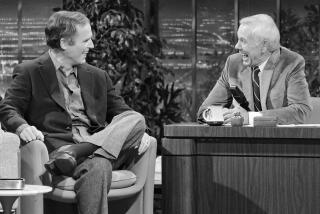Consultant Defends Air Terminal Plan
- Share via
A consultant for Burbank Airport on Monday defended the airport’s plans to build a new, larger terminal building against complaints by nearby homeowners that a larger facility will increase street traffic and aircraft noise in surrounding neighborhoods.
The Burbank-Glendale-Pasadena Airport Authority is scheduled to choose one of five terminal replacement plans on March 22, including one plan for a terminal about four times the size of the current 163,344-square-foot building.
A representative of KPMG Peat Marwick, which was hired by the airport to complete an environmental study of the five terminal plans, said at a hearing Monday that the larger terminal will accommodate the 5.4 million passengers expected to use the airport by 1998.
The increased passenger volume will mean added flights and increased auto traffic on adjacent streets, the representative said. But he said such increases would have occurred regardless of whether a larger terminal were built, and therefore airport officials are not obligated under state or federal laws to remedy the undesirable side effects they cause.
Ron Tulis, a principal of the New York-based accounting firm, said the number of passengers using the airport will increase anyway because of market forces, not because they are attracted by the size of the new terminal.
“You can build all types of Taj Mahals and gates and you can still not get more demand,” he said. “The mere presence of a large terminal and gates does not create demand.”
The environmental report addresses questions and criticisms raised at public hearings in August and September by 28 airport neighbors. The report also addresses questions raised by 23 government agencies, elected officials, business organizations and homeowner groups.
Tulis said many of the groups and individuals asked why the environmental study did not address the noise increase they expect the airport to cause in the future.
He said the increased traffic volume will most likely mean more noise. But he added that market demand, not construction of a larger terminal, would be the cause of that increased noise.
“The terminal does not create noise,” he said.
Tulis pointed out that the airport has already conducted a federally approved study to reduce airport noise.
Airport Commissioner Bob Bowman, a Burbank city councilman, also noted that the airport has spent about $2.5 million to install sound-dampening windows and insulation at an elementary school under the airport’s flight path.
About 50 people attended the hearing Monday. However, only two spoke to the airport authority about the new terminal, including Melvin Perlitsh, a Burbank resident and longtime critic of the airport.
During his comments, Perlitsh dropped a copy of the environmental study on the ground, calling it “a bunch of garbage.”
He noted that when the cities of Burbank, Glendale, and Pasadena purchased the airport in 1978, they signed a joint-powers agreement that stipulated that the authority would do nothing to increase aircraft noise generated by the airport.
But Perlitsh charged that noise has continued to increase.
“You should not promise what you cannot fulfill,” he said.
Noise studies provided to the state by airport authorities, however, show that noise level measured under federal guidelines has decreased since 1978.
To meet the demand projected for the year 2010, the airport will need to accommodate 326,000 landings and takeoffs annually, an increase from the 238,000 annual operations currently, said Robert Doyle, another representative of Peat Marwick.
Several members of the airport commission have said that the favored terminal proposal calls for construction of a two-level, 670,000-square-foot facility on about 140 acres of land on the northeast boundary of the airport. The land, owned by the Lockheed Corp., had been used in the past for secret government projects by Lockheed’s advanced military design group, nicknamed “the Skunk Works.”
Depending on which of the five alternatives is chosen, between seven and 10 nearby street intersections would reach traffic capacity by 1999 due to the increased passenger volume, according to the environmental study. By the year 2010, when the airport is expected to attract about 10 million passengers a year, between 11 and 15 intersections will be significantly affected, it said.
Although Tulis said airport officials are not responsible for mitigating negative side effects created by the increased passenger volume, the study suggests re-striping existing intersections, purchasing additional rights of way to construct new traffic lanes, and even building elevated streets. The study does not say how much the traffic measures would cost.
Proposed Airport Terminal Alternatives The Burbank Airport Authority is considering the airport terminal with one of five alternative plans for buildings of various heights. The 163,344-square-foot terminal is too close to the runways to meet federal safety standards. Existing. Alternative 1: A 670,000-square-foot, two-level building. It is the preferred alternative of several airport officials. Alternative 2; The 670,000-square-foot terminal is split, with parking and ticket counters east of the main runway and the airplanes and boarding gates on the west. A tunnel would connect the two sides. Alternative 3: Also 670,000 square-feet, but with parking and ticket counters west of the main runway and airplanes and boarding gates ont he east. A tunnel would connect the two sides. Alternative 4: A 465,000-square-foot building east of the main runway. Alternative 5: A 465,000-square-foot building west of the main runway.
More to Read
Sign up for Essential California
The most important California stories and recommendations in your inbox every morning.
You may occasionally receive promotional content from the Los Angeles Times.














